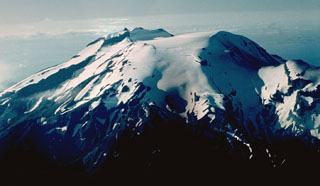Report on Calbuco (Chile) — 19 August-25 August 2015
Smithsonian Institution / US Geological Survey
Weekly Volcanic Activity Report, 19 August-25 August 2015
Managing Editor: Sally Sennert.
Please cite this report as:
Global Volcanism Program, 2015. Report on Calbuco (Chile) (Sennert, S, ed.). Weekly Volcanic Activity Report, 19 August-25 August 2015. Smithsonian Institution and US Geological Survey.
Calbuco
Chile
41.33°S, 72.618°W; summit elev. 1974 m
All times are local (unless otherwise noted)
According to the civil protection agency, ONEMI, on 18 August OVDAS-SERNAGEOMIN reported that seismicity at Calbuco fluctuated at low levels and continued to decline, and only water vapor emissions rose from the vents. The Alert Level was lowered to Green (the lowest level on a four-color scale). ONEMI maintained an elevated Alert Level of Yellow (mid-level on a 3-color scale) for the Llanquihue and Puerto Octay provinces, and an Alert Level Green for Puerto Montt and Puerto Varas. On 21 August the 10-km exclusion zone around the volcano was lifted, but SERNAGEOMIN warned that the 1.5 km exclusion zone around the craters remained in effect and the public should continue to stay away from drainages.
Geological Summary. Calbuco is one of the most active volcanoes of the southern Chilean Andes, along with its neighbor, Osorno. The late-Pleistocene to Holocene andesitic volcano is immediately SE of Lake Llanquihué in the Chilean lake district. Guanahuca, Guenauca, Huanauca, and Huanaque, all listed as synonyms of Calbuco (Catalog of Active Volcanoes of the World), are actually synonyms of nearby Osorno volcano (Moreno 1985, pers. comm.). The edifice is elongated in a SW-NE direction and is capped by a 400-500 m wide summit crater. The complex evolution included collapse of an intermediate edifice during the late Pleistocene that produced a 3-km3 debris avalanche that reached the lake. It has erupted frequently during the Holocene, and one of the largest historical eruptions in southern Chile took place from Calbuco in 1893-1894 that concluded with lava dome emplacement. Subsequent eruptions have enlarged the lava-dome complex in the summit crater.
Source: Oficina Nacional de Emergencia-Ministerio del Interior (ONEMI)

